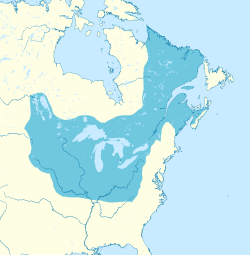
Canada (New France)
French colony in North America from 1535 to 1763 / From Wikipedia, the free encyclopedia
Dear Wikiwand AI, let's keep it short by simply answering these key questions:
Can you list the top facts and stats about Canada (New France)?
Summarize this article for a 10 year old
The colony of Canada was a French colony within the larger territory of New France. It was claimed by France in 1535 during the second voyage of Jacques Cartier, in the name of the French king, Francis I. The colony remained a French territory until 1763, when it became a British colony known as the Province of Quebec.[5][6][7][8]
Canada | |||||||||
|---|---|---|---|---|---|---|---|---|---|
| 1535–1763 | |||||||||
The royal banner of early modern France or "Bourbon Flag" was the most commonly used flag in New France[1][2][3]
The lesser coat of arms of France
as used by the Government | |||||||||
 Map of Canada after 1713. At its fullest extent, Canada extended from south of the Great Lakes to the Gulf of St Lawrence. | |||||||||
| Status | Colony of France within New France | ||||||||
| Capital | Quebec | ||||||||
| Common languages | French | ||||||||
| Religion | Catholic Church (state religion)[4] | ||||||||
| Government | Monarchy | ||||||||
| King | |||||||||
| Governor | |||||||||
| History | |||||||||
• French territorial possession | 1535 | ||||||||
• Founding of Quebec | 1608 | ||||||||
• Founding of Trois-Rivières | 1634 | ||||||||
• Founding of Montreal | 1642 | ||||||||
| 1763 | |||||||||
| Currency | New France livre | ||||||||
| ISO 3166 code | CA | ||||||||
| |||||||||
| Today part of | Canada United States | ||||||||
In the 16th century the word "Canada" could refer to the territory along the Saint Lawrence River[9] (then known as the Canada River) from Grosse Isle to a point between Québec and Trois-Rivières.[10] The terms "Canada" and "New France" were also used interchangeably.[11] French explorations continued west "unto the Countreys of Canada, Hochelaga, and Saguenay"[12] before any permanent settlements were established. In 1600 a permanent trading post and habitation was established at Tadoussac at the confluence of the Saguenay and Saint Lawrence rivers. However, because this trading post was under a trade monopoly, it was not constituted as an official French colonial settlement.
The first official settlement of Canada was Québec, founded by Samuel de Champlain in 1608.[13][14] The other four colonies within New France were Hudson's Bay to the north, Acadia and Newfoundland to the east, and Louisiana far to the south.[15][16] Canada became the most developed of the five colonies of New France. It was divided[when?] into three districts, Québec, Trois-Rivières, and Montreal, each with its own government.[citation needed] The governor of the District of Quebec also served as the governor-general for all of New France.[16][failed verification]
The Seven Years' War of 1756–1763 saw Great Britain defeat the French and their allies, and take possession of Canada. In the Treaty of Paris of 1763, which formally ended the Seven Years' War, France ceded Canada in exchange for other colonies, with a large portion of Canada becoming the British colony of the Province of Quebec.[17]
Oops something went wrong:

